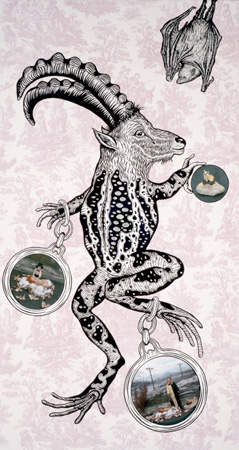
Lezley Saar's "Autist's Fables," an oeuvre she created over a span of two years, seems to be a continuation of her former body of work, "Mulatto Nation," in which dichotomy and the anomalies of nature, too, play a key role. Saar's current body of work invites viewers into the world of her 18-year-old autistic daughter Geneva, to learn to appreciate her creativity, sensitivity, penchants and overcoming isolation. The solo exhibition contains a combination of illustrations with circular color photographs collaged into paintings, glass-encased dioramas, and the gallery's smaller exhibit hall set up as a living room, in which gothic-looking photographs in ornate golden frames decorate the walls and a small TV monitor encircled by red velvet curtains shows the court metrage--short film--Le Mystere de Genevieve.
The influence of Aubrey Beardsley in Saar's paintings is obvious. There are the black ink illustrations on pastel-hued backgrounds, the sinuous lines and curvy shapes, creating interesting negative spaces. Overall the exhibit is created as a third-person narrative, part of it written down in English, part of it told in French, as in Saar's short film. The tale employs lifeless figures and Victorian settings similar to Edward Gorey's stories. Although autobiographical, it uses techniques of fiction: Geneva is Genevieve, Lezley is Lisette, and Geneva's father is Albert. The story unfolds with the key steps in Geneva's development, including her birth, her loss of speech, the fantasy world she creates as a little girl in which villains and imaginary friends appear and dolls that allude to the children she won't be able to bear. Part of the narrative applies fable elements in the manner of Aesop and Jean de La Fontaine. Mysterious looking hybrid animals are its main protagonists, delivering the moral that autism, as any other deviation from the norm, should be accepted in society. In contrast to paintings such as Imaginary Life, Imaginary Friends; A Calendar Savant; A Beautiful Initiation; All the Months Had a Special Color; and A Very Sensitive Child, in which the positive, extraordinary sides of Geneva's personality are accented, the photographs Bad Seed Boy Villain; Family Portrait on Stage; Genevieve with saw; Genevieve with Tall Friend and Bad Seed Boy, seem to acquaint us with her sometimes aggressive tendencies. Generally, the exhibit conveys beauty, complexity, mystery, perplexity, and enchants viewers into another reality.
This article was written for and published in art ltd. magazine ![]()
